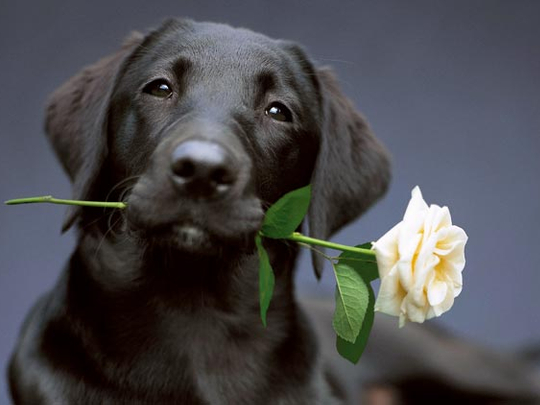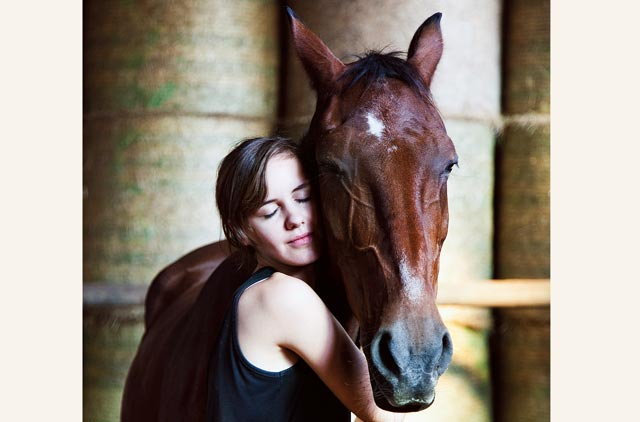
Anyone who doubts that dogs love their owners only has to read the story of Greyfriars Bobby, the loyal police hound. According to reports, he belonged to Constable John Gray who served in the Scottish police force in the mid-19th Century and walked the beat in Edinburgh Old Town; a bustling part of the city where robbery and disorder were rife.
During the long cold nights, Bobby was Gray’s companion. In documents Skye terrier Bobby is described as, “Tenacious in character, distrustful of strangers but devoted to family and friends, he was courageous but not aggressive. No other sort of dog has more gritty tenacity, cockiness or sparkle than a Skye terrier with one particular noted quality – loyalty.”
After Gray died of tuberculosis in 1858, Bobby’s loyalty became a national sensation. Legend has it that the day after Gray’s funeral, Bobby was discovered sitting on top of his master’s freshly dug grave in Greyfriars Kirkyard. He was ushered away but returned again and again and finally kept a mournful vigil on the grave for 14 years until he died in 1872. In Edinburgh he is a legend. There is a plaque marking where he ate, a bar named in his honour and statue to commemorate him.
If true, the story proves beyond doubt that Bobby loved his owner and that dogs can experience deep emotions. But did Bobby really mourn? Subsequent research suggests that the story of Greyfriars Bobby is just that – a shaggy dog’s tale.
So can animals experience emotions? There are documented cases of elephants performing burial rituals, primates honouring their dead and pet parrots displaying jealousy... but are they emotional beings? Do they feel what we feel? These questions have puzzled philosophers and scientists for hundreds of years. They go to the heart of the debate about the ethical treatment of animals.
One person who may have the answers is Sonja Gehlsen, an animal behaviour expert who offers bespoke dog training programmes to pet owners through her Abu Dhabi-based company Dogversation.
She trained for six months with Hans Schlegel, the Swiss dog whisperer and one of the world’s top dog trainers. Gehlsen graduated in the fields of dog behaviour analysis, family dog training, puppy training, motivational techniques, creative dog activities and training of dogs showing unwanted hunting behaviour. Veterinary clinics recommend her services and in addition to providing personal sessions in puppy training, basic and advanced obedience and creative dog activities, she also specialises in therapeutic training measures such as the re-socialisation of adopted street dogs. She knows a thing or two about canine behaviour.
In Sonja’s view, what we term as ‘love’ in animals is a matter of definition. “When we deal with a dog, we always have to keep in mind that we are not dealing with a child or a fellow human being but with a domesticated predator that is born as a pack animal with its own specific social, hunting and territorial instincts,” she says.
“A dog certainly has a strong ability to relate, connect and be loyal to its human owner. However we need to be very careful when comparing dogs to humans. Dogs have a very complex social structure and being pack animals, they obey different rules than humans do. When we observe our dogs, we easily draw human conclusions but as owners we need to make sure to respect their ‘doggy’ needs and treat them as dogs, not humans.”
Define what you mean by ‘love’
Natural history broadcaster Sir David Attenborough also warns against drawing human conclusions about animal behaviour.
“It is possible to over-anthropomorphise animals,” he says. “You have to define what you mean by love. Of course there are bonds between a dog and its master but I don’t think animals are capable of love.”
Those bonds between humans and dogs are a product of around 15,000 years of co-evolution. Any devoted dog owner will attest that their pet fits easily into the structure of their family, but does the animal feel empathy with them? The field of animal behavioural studies is relatively new and recent research is beginning to suggest that animals are more sophisticated than we assume.
The first scientist to explore the idea that animals possess emotions was Charles Darwin. His theory of evolution suggests that humans share a common evolutionary inheritance with animals.
On this basis there is a logical conclusion that dictates we also share emotions because, in functional terms, they are the things that help us to organise our behaviour to do the things we need to survive. External emotions directed towards others are the oil that lubricates our often complex social interactions.
Experiments have suggested animals can display behaviour we interpret as sympathy, generosity and even injustice. For example, in 2002 Frans de Waal, a professor of psychology at Emory University in Atlanta, studied how monkeys reacted to reward. In the experiment the animals were trained to hand a stone to a researcher in exchange for food.
Initially they were all given cucumber. When a better reward in the form of a grape was given to some and not others, the monkeys with the cucumber became agitated and in some cases refused to perform the task. This reaction looked very much like indignation.
In another similar experiment, generosity was observed between Capuchin monkeys trained to exchange tokens for food. One type of token released two slices of apple for the individual token-holder and another released one slice for the token-holder and one for another monkey. The monkeys were more likely to choose the generous option and share the slices with another when that monkey was from a companion group.
While these older studies hint at emotional bonds between members of the same species, they do not prove whether those emotions are displayed in inter-species relationships.
This area was investigated more recently by researchers at Goldsmiths College in London who set out to see if dogs could detect the emotional state of humans by recording their reactions when a human nearby began to cry or hum in an odd way, to make the dogs curious. Eighteen dogs were placed in various scenarios with humans. In some scenarios the dog’s owner cried, in some a stranger cried.
The authors of the subsequent report on the study, Dr Deborah Custance and Jennifer Mayer, wondered if exposure to crying led dogs to feel distress and if so, would they go to their master for comfort regardless of who was crying. They also theorised that if curiosity rather than empathy was the driving force behind the dogs’ reactions then the humming would make the dog engage with people.
The results, reported in scientific journal Animal Cognition, showed that “person-orientated behaviour” sometimes took place when a person was humming but it was more than twice as likely to occur if someone was crying. In all, 15 dogs showed person-orientated responses when the stranger cried and every one directed those responses towards the stranger rather than their owner.
The conclusion drawn is that dogs have the ability to express emphatic concern and the capacity to experience sophisticated secondary emotions.
Trusting their instincts
Dr Paul Morris is principal psychology lecturer at the University of Portsmouth in the UK and is one of the world’s leading researchers into emotions in non-primates. His work focuses on secondary emotions in animals. Mammals all display instinctive emotions vital for survival such as fear and aggression, but the more complex emotions, such as love and jealousy, are used for social purposes.
Instinctive emotions are controlled by an area of the brain called the reptilian brain. In evolutionary terms this is the oldest and most primitive structure in the brain.
Overlaying this is the limbic system or old mammalian brain. This is where secondary emotions reside. All mammals, whether human or mouse, share these anatomical structures and they perform the same functions in different species.
Dr Morris maintains that without the ability to experience secondary emotions, animals that live in groups and rely on group structures for survival would not be able to co-habit in social communities.
“The neural equipment is there for doing some sophisticated stuff,” he says. “Primary emotions like anger and fear keep the animal safe but secondary emotions like jealousy, guilt and empathy are social emotions for regulating social interactions. Animals live in sophisticated groups. How is their behaviour being regulated within those groups? If it isn’t being done by emotions what is it being done by?
“For communities of animals to cohere together they need to have strong social bonds and a mutual shared interest. They need love; love between each other and love in the form of bonds to their offspring. It would be weird if animals that live in packs didn’t have love and affection for each other.
“From a scientific perspective there has always been a reluctance to prove that animals do sophisticated things and a worry about anthropomorphising them. I started off with the facts that animals do sophisticated things; they perform cooperative hunting, they co-raise offspring, they live in hierarchical structures. If it is not emotions regulating these behaviours, are they sitting down and discussing them? I think emotions are a more parsimonious explanation to how they are achieving this level of sophistication. The incontrovertible fact is that they are doing sophisticated stuff in terms of social structure and interaction.”
Indeed when analysed, there is usually a very good evolutionary reason for each specific emotion. In the case of empathy, it is important for an animal to be able to identify another animal in distress. And jealousy is important for protecting a mate and also for protecting other social relationships within a group.
As Morris explains: “Animals form alliances within groups, some people may interpret
these as friendships.
“To be aware of those alliances and to be protective of them is very sensible. If you were attacked by someone higher up in the hierarchy or if someone challenges your position from lower down, it is important to have solidarity with others who are going to support you or at least not join in with the attack. ”
The little green-eyed monster
Although we may never know whether the jealousy or love a dog experiences feels the same as the jealousy and love we feel, Morris believes they are deeply related.
“I would never claim that dog jealousy is like human jealousy,” he says. “I think in animals emotion is in the moment, but there is something prototypical about it.”
The suggestion is that the love we feel for our children has evolved from the care a dog shows to its pup. When a horse raises its head and rears up in a display of virility for other horses in a field, this is the primitive origin of human pride.
This belief, which is underpinned by scientific research, leaves deep philosophical questions about the relationships between humans and animals.
Earlier this year scientists took the bold step of proposing to the international community that dolphins and whales – both highly intelligent and sociable creatures – should be recognised as “non-human persons” and given their own bill of rights with the same rights to life, liberty and wellbeing as humans.
Dr Thomas White, an ethics expert at Loyola Marymount University in California, says, “The similarities between cetaceans and humans are such that they, as we, have an individual sense of self. Dolphins are non-human persons. The science has shown that individuality, consciousness and self awareness is no longer a unique human property. That poses all kinds of challenges.”
They are challenges that increasingly we will face as our understanding of what goes on inside animal minds continues to expand.














